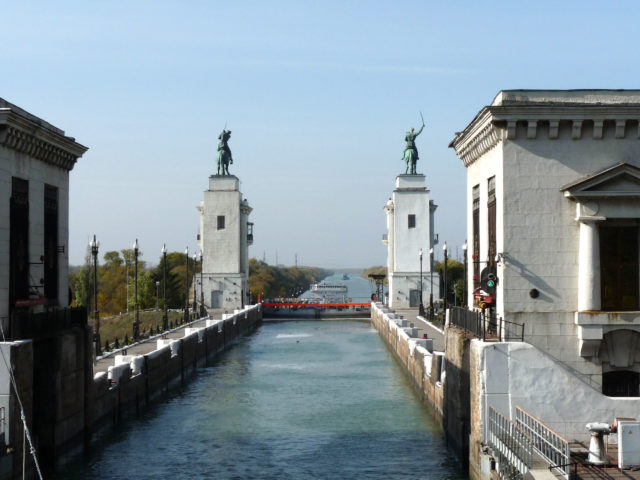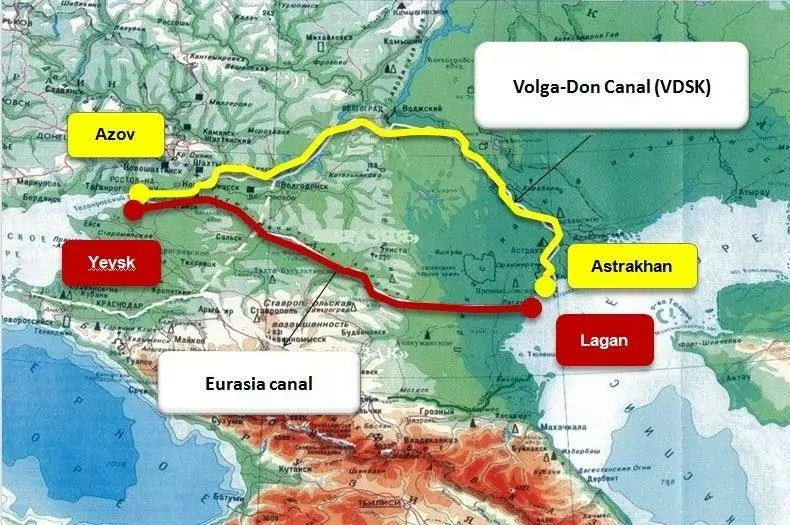
Volga-Don Canal, Last Great Stalin Project, Desperately Needs Updating or Replacement
Publication: Eurasia Daily Monitor Volume: 17 Issue: 116
By:

The Volga-Don Canal, the last of the great Stalinist-era construction projects, which involved the use of German prisoners of war and Soviet GULAG prisoners to move more than 150 million cubic meters of earth and pour more than 3 million tons of concrete, marked its 68th anniversary at the end of July (Parlamentskaya Gazeta, July 27; Casp-geo.ru, July 29). Despite its age, the canal remains an important transportation artery for the Russian Federation, which relies far more on internal waterways to move bulk cargo than almost any other country. And in the last several years, this riverine route has only increased in importance because of Moscow’s use of it to shift naval vessels from the Caspian Sea to the Sea of Azov adjoining Ukraine (see EDM, May 31, 2018).
Yet, the aging canal is deteriorating; moreover, it is too shallow and has too many locks to be able to handle larger ships. Therefore, it has become an ever more serious transit bottleneck for Russia, prompting talk of deepening and widening it or replacing it with a shorter and more modern canal system with fewer dams and locks through the North Caucasus. Unless Moscow is prepared to suffer serious economic and even security losses, the Russian authorities have little choice but to do one or the other, although current budgetary stringencies and Moscow’s present inability to secure foreign financing for either project leaves it in a bind. The West is unlikely to provide money because of how Moscow has used the Volga-Don Canal against Ukraine; and China, the most obvious alternative source, does not, at present, identify the canal as part of its “one belt, one road” links between the Pacific rim and Europe.
Despite its problems, the Volga-Don Canal for now remains the only water connection between the Caspian and the world oceans. Consequently, it plays a key role in the economies of southern Russia, the South Caucasus and Central Asia. The canal extends 101 kilometers, 45 of which pass through reservoirs, and it has a registered depth of not less than 3.5 meters—although silting and the absence of regular dredging mean that in places it is likely much less than that. (A short-lived effort to build a new, deeper channel alongside the existing one died in the 1980s, just as the Soviet Union was coming to an end.) At the end of 2019, journalist Aleksandr Yemelchenko reported on exactly how poor the Volga-Don Canal’s condition has become, after travelling along this and other Russian internal waterways (Newizv.ru, January 11, 2019).
Yemelchenko’s article reaches some damning conclusions. As appalling as Russia’s notoriously bad roads may be, he says, the state of its waterways, including the Volga-Dona canal, is “even worse.” Most river channels have not been repaired or even dredged since the end of Soviet times, increasing the number of accidents and making portions impassable for all but the smallest and least heavily weighted vessels. Moreover, the entire Russian river fleet is left over from Soviet times: “there has not been a single new boat since.” Officials dispute that, Yemelchenko writes; but he himself has not seen nor met any Russian living along these waterways who could point to any examples of newly constructed riverine craft. As a result, waterways like the Volga-Don Canal, which are supposed to promote domestic economic development and trade, cannot do their job; and the Russian Federation is suffering. “I very much hope for positive changes,” he says, “because without them, the country will simply disappear and be reduced to nothing even without any wars. It will drown in vodka and simply disintegrate.”
The shortcomings of the Volga-Don Canal were highlighted in May 2018, when Moscow decided to move five naval vessels from its Caspian Flotilla to counter Ukrainian shipping in the Sea of Azov. Only the smallest ships of the Flotilla could make their way across southwestern Russia; and problems with passage through the canal meant that even they could not be moved rapidly. As a result, some in Moscow and the North Caucasus began to discuss the possibility of wholly replacing the Volga-Don Canal given that modernization efforts, even if they were actively undertaken, would not be enough ensure that the nearly 70-year-old waterway could continue to serve Moscow’s security interests (see EDM, March 26, 2019).

Plans to build a canal across the North Caucasus isthmus have a long and inglorious history. They have been announced but not followed through on many times since the 1930s, invariably taking a back seat to other megaprojects. However, now that the Kremlin has begun to define the issue as one of national security rather than merely economic development, that may change. Over the last two years, Moscow has been devoting ever more attention to its security interests on the Caspian and that sea’s littoral (see EDM, November 27, 2018). As a result, some Russian federal subjects in the region, Dagestan, Kalmykia and Astrakhan in particular, have begun to compete to be the anchor of such a project. In late July, Moscow gave the nod to Kalmykia by approving plans for an expanded Caspian port there (Mk-kalm.ru, July 31, 2020).
More than a decade ago, advocates of a new waterway between the Caspian and the Black Sea christened the project “the Eurasian Canal”; and it continues to be discussed under that name. According to Moscow’s thinking at that time, the canal would be 700 kilometers long (four times as long as the Suez Canal) and 6.5 meters deep (almost twice the depth of the Volga-Don). It would obviously be extremely expensive and take a long time to build, even if money is found (see EDM, June 25, 2007 and October 1, 2010).
But if the Eurasian Canal is ever built and does supplant the Volga-Don channel, this new internal waterway would give Moscow new security options and expanded economic possibilities. It would thus serve as a bold reminder that even in the 21st century, riverine routes can transform the geopolitics of a region just as much as railroads and highways (see EDM, February 18, April 28, May 4, 13).



